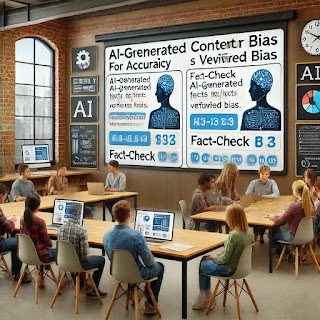AI Practice for Teacher Candidates: Day 89 — Developing Critical Thinking Skills with AI Content Analysis
Welcome to Day 89 of the 100-Day Journey!
AI-generated content is becoming more prevalent in education, but it’s not always accurate or unbiased. Today, we’ll explore how students can critically analyze AI outputs, verify sources, and develop digital literacy skills.
Why Teach AI Content Analysis?
- 🔍 Improves Digital Literacy: Students learn to distinguish between credible and misleading information.
- ⚖️ Identifies AI Bias: AI-generated content can reflect biases—students must recognize and challenge them.
- 🧠 Strengthens Critical Thinking: Encourages deeper inquiry into AI-generated text, images, and data.
AI Tools for Analyzing Content Accuracy & Bias
-
📌 AI Fact-Checking Tools
- Tool Example: Google Fact Check Explorer, Snopes, ChatGPT with verification prompts.
- Purpose: Helps students cross-check AI-generated information with verified sources.
-
📌 AI Bias Detection & Awareness
- Tool Example: AI Bias Detector, Perspective API.
- Purpose: Highlights potential bias in AI-generated content.
-
📌 AI-Generated Content Analysis
- Tool Example: GPTZero (AI detection), Hugging Face Bias Analysis.
- Purpose: Determines if content was generated by AI and examines its neutrality.
-
📌 AI for Source Comparison
- Tool Example: Elicit.org (AI research tool).
- Purpose: Uses AI to compare multiple academic sources for accuracy.
Practical Task: AI Content Fact-Checking Activity
-
Analyze AI-Generated Statements
- Provide students with AI-generated text and ask them to verify facts using reliable sources.
-
Compare AI vs. Human-Written Content
- Have students evaluate tone, bias, and accuracy between AI-generated and expert-authored texts.
-
Identify Bias in AI-Generated Responses
- Give students prompts that could lead to biased AI responses and discuss findings.
-
Create an AI Fact-Checking Guide
- Students develop a checklist for evaluating AI-generated information in their learning.
Reflection Questions
- What are the risks of relying on AI-generated content without verification?
- How can students be trained to recognize AI bias and misinformation?
- What role should educators play in helping students fact-check AI outputs?
Pro Tip: Encourage a Skeptical Mindset
Teach students to question AI-generated content, just as they would any other source of information.
Looking Ahead
Tomorrow, we’ll explore how AI can support problem-solving and creative challenges, helping students become innovative thinkers.
You're fostering critical thinkers—keep guiding students to analyze AI with a discerning eye! See you on Day 90! 🚀✨
